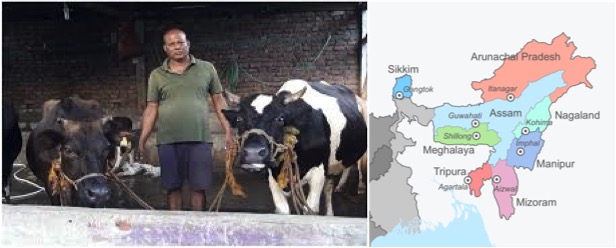For India’s dairy sector, the next wave of growth is set to come from the eastern States. It is not just the dairy players that have spotted a potential market in the region, policy guidance also encourages development in these ‘dairy underdeveloped States.’
In an interview with BusinessLine, Dilip Rath, Chariman of National Dairy Development Board (NDDB), highlighted that for India to retain over 6 per cent of milk production growth, there should be inclusivity in growth.
“If we look at the different States which contribute to the milk pool of the country, there are certain States which are left behind — primarily those in the East and North-East. We can maintain over 6 per cent growth in the dairy sector if these States reach the all-India average milk yield production,” Rath said.
Challenges in North East
“They have got the animal wealth. But their milk yield is low. We need to prioritise in terms of how to enhance productivity of animals in those so-called ‘dairy underdeveloped States’,” Rath said.
As per the 20th Livestock Census, West Bengal, Bihar, Jharkhand, Assam and Odhisha together have a cattle population of 66.3 million, which is about one-third of the country’s total of 192.52 million. However, these States have negligible share in the total milk production of 187.75 million tonnes for 2018-19.
Bihar and West Bengal contribute about 5.2 per cent and 3 per cent, respectively, to the country’s milk pool, while the remaining eastern States contribute less than 1 per cent despite having rich animal wealth.
The Gujarat Cooperative Milk Marketing Federation (GCMMF) — marketeer of the Amul brand of products — has spotted an untapped market in the East and North-East. The dairy giant had already started testing the waters in Bihar and Jharkhand.
“In the North-East, we have started with Guwahati but, this year, we are adding other cities and also starting milk procurements,” said RS Sodhi, Managing Director, GCMMF, adding that Odisha will also be a big market.
Co-op model
Raising concerns of a successful dairy development model, Rath stated that Verghese Kurien, the father of the White Revolution in India, gave a mantra for a successful Operation Flood — replicate Anand’s cooperative dairying model across the country.
“The question is that how do we take dairying forward in these States? We have to build institutions. Are the cooperatives strong enough in these States? Even if we see certain issues now in the traditional forms of producer-owned organisations like cooperatives, we have to look at alternative producer-led institutions,” he added.
Milk stats
Production of milk in eastern India is estimated at 46.84 million litres per day, out of which roughly 55 per cent is consumed by farmers in-house, and 50 per cent of the balance (45 per cent) goes to organised sources, said Mayank Jalan, Chairman and Managing Director, Keventer Agro Ltd.
The processing capacity is in excess of 14 million litres per day, both private and public dairies combined.
“Consumption of pouched milk is growing at 3-4 per cent per annum across eastern India. With proper government support and intervention, the production of milk can be moved upwards of 60 million litres per day,” he said.
With inputs from Shobha Roy in Kolkata
Source : The Hindu Businessline


[…] Also read : Dairy players looking towards Eastern India […]
[…] Also read : Dairy players looking towards Eastern India […]